ATMS (Advanced Technology Microwave Sounder)
EO
Cloud profile and rain radars
Atmosphere
Cloud type, amount and cloud top temperature
Quick facts
Overview
| Mission type | EO |
| Agency | NOAA |
| Mission status | Operational (extended), Operational (nominal) |
| Launch date | 28 Oct 2011 |
| Measurement domain | Atmosphere, Snow & Ice |
| Measurement category | Cloud type, amount and cloud top temperature, Atmospheric Temperature Fields, Surface temperature (land), Surface temperature (ocean), Atmospheric Humidity Fields, Atmospheric Winds |
| Measurement detailed | Atmospheric specific humidity (column/profile), Atmospheric temperature (column/profile), Air temperature (near surface), Turbulence |
| Instruments | Sounder |
| Instrument type | Cloud profile and rain radars, Other |
ATMS (Advanced Technology Microwave Sounder)
Key instrument for Weather Prediction
For a little-known satellite instrument, the microwave sounder has a major impact on our lives. These instruments feed the weather models that inform our daily forecasts and help us plan for extreme weather. And their long-term temperature records of our atmosphere have played a key role in helping scientists determine that humans are the cause of climate change. The Advanced Technology Microwave Sounder (ATMS), is the size of a mini fridge, and it’s hitched to the Joint Polar Satellite System’s NOAA-20 and Suomi-NPP satellites. 1) 2)

Some instruments launched into space spend so much time in the spotlight that their missions become household names: Hubble, Perseverance, the James Webb Space Telescope.
Others do their job quietly, delivering a steady flow of data that slips unnoticed into decisions we make every day: Simple decisions, like rain boots or sunscreen. But pressing ones too, involving sandbags and boarding up windows; finding shelter or preparing to evacuate.
Sounders can also measure the insides of hurricanes. Knowing the temperature of different parts of the hurricane helps forecasters understand a storm’s direction and its strength. Consider Hurricane Laura, which made landfall in August 2020, hammering the Texas and Louisiana coasts with 150 mile-per-hour winds. The storm destroyed buildings, blew windows out from high rises, downed trees and power lines, ripped the top off a bridge and triggered a fire at a chemical plant.
Because of ATMS and other sounders, state officials had advance warning of the storm’s potential path and intensity and were able to evacuate people, saving lives.
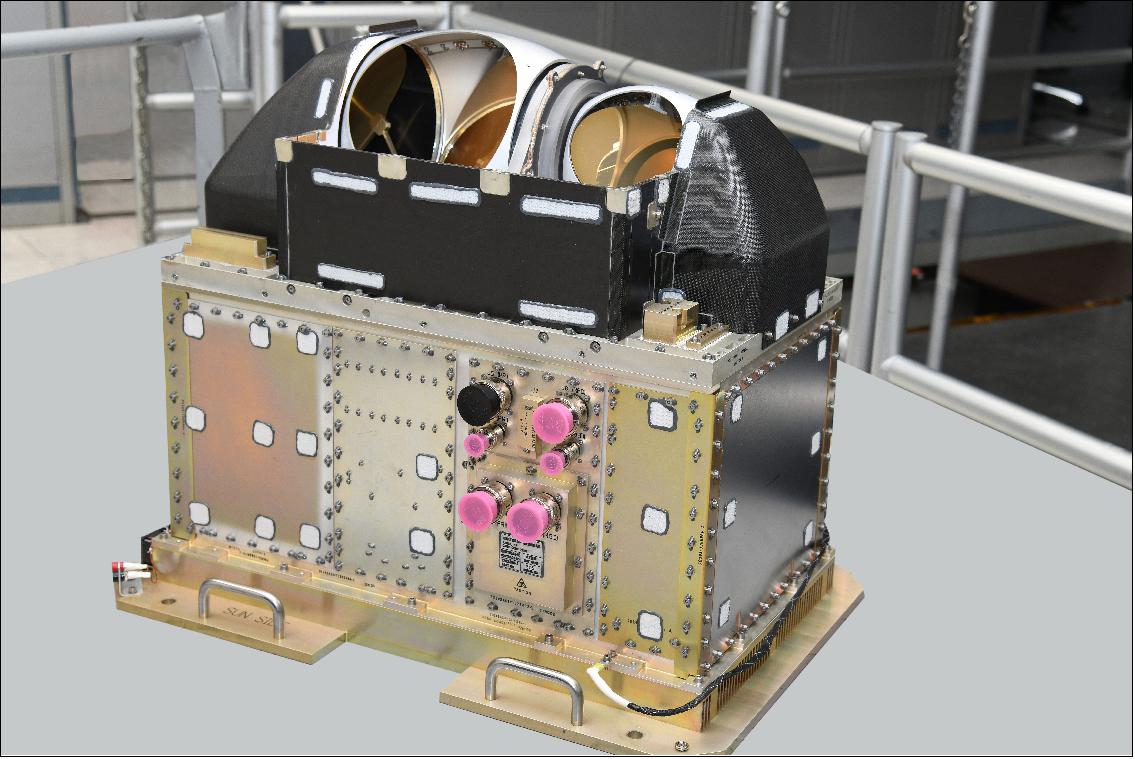
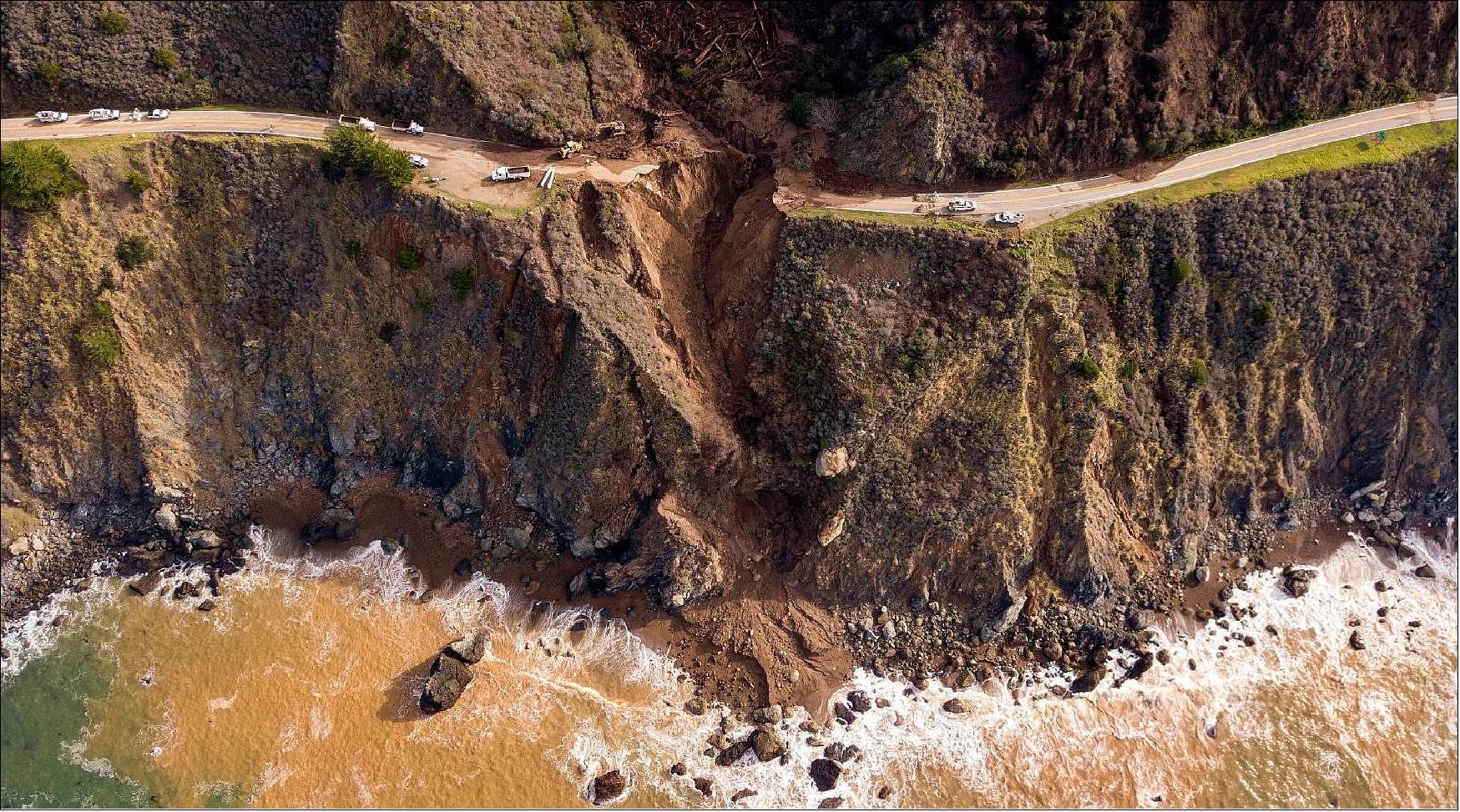
In the days leading up to this event, microwave sounders probed the atmosphere vertically, piercing through the clouds to capture multi-layered data on temperature and moisture. Their measurements alerted forecasters to an atmospheric river, a narrow storm system that transports tremendous amounts of moisture through the atmosphere. An atmospheric river moves as much as 15 times more water through the air than the amount that flows through the mouth of the Mississippi.
The satellites beamed the data from the sounders back to Earth. The data were collected by giant antennas on the ground and fed into global weather models. The models were studied by forecasters. And forecasters gave residents in Monterey, San Francisco Bay and the Sierra Nevadas early warning on severe weather headed their way.
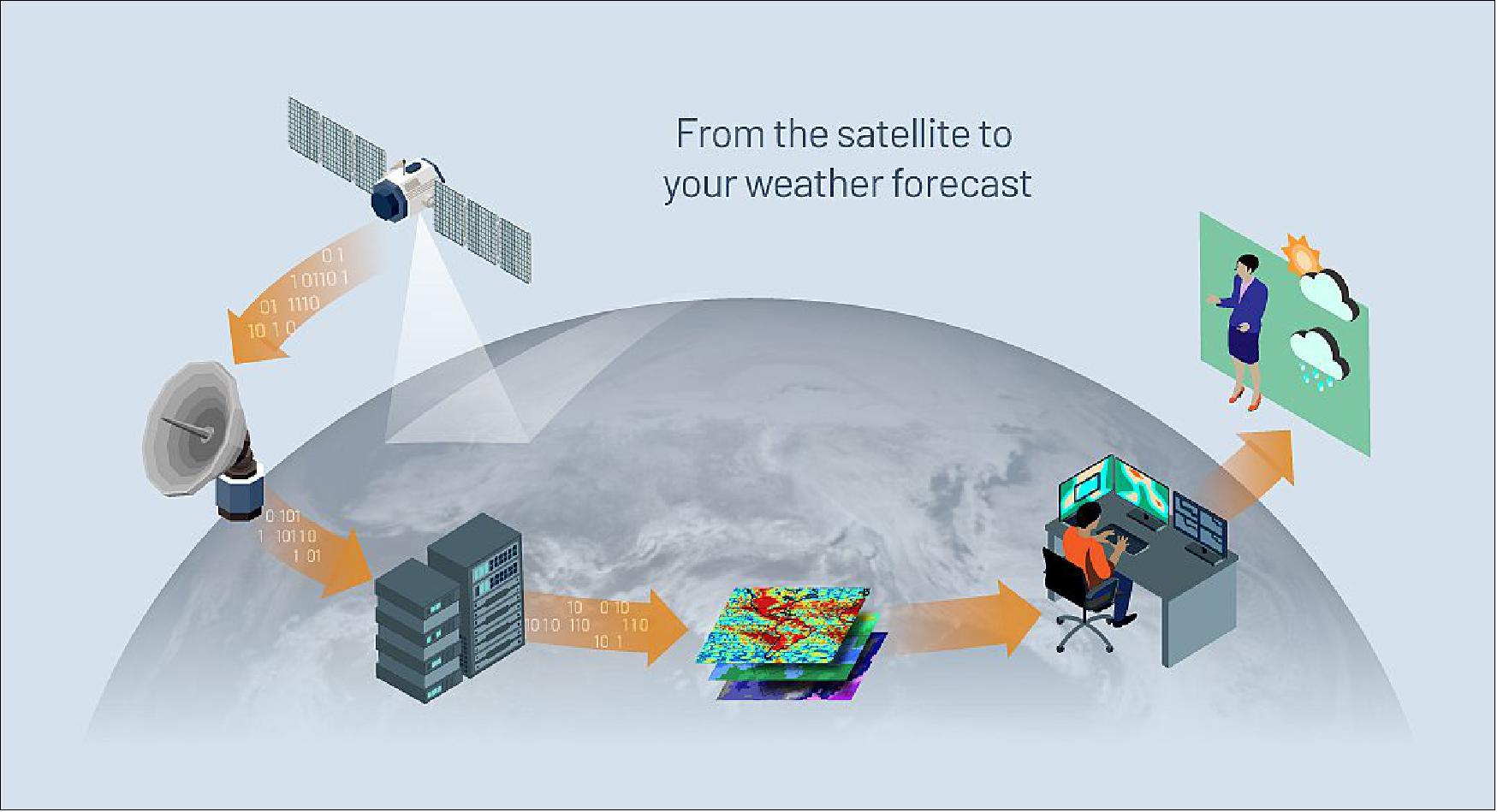
ATMS, like other microwave sounders, measures atmospheric temperature and water vapor from Earth's surface to the upper atmosphere — all over the globe.
And because the distribution of temperature and water vapor is the driver for accurate weather forecasts, — "the fuel for forecasting,” Goldberg called it — “ATMS," he said, "provides one of the most critical datasets for weather prediction.”
The Fuel for Forecasting
At the Northrop Grumman facility in Azusa, California, Danielle Gallegos oversees a team of 100 people who build and test the ATMS instrument, and integrate it into the bigger spacecraft. There, engineers are hard at work building more ATMS instruments for three identical satellites that will follow NOAA-20, providing measurements until at least the late 2030s.

ATMS, which includes an antenna, a motor, a radio frequency system and an electronic system, is made up of many custom-made components. And every component requires tuning and absolute precision in order to produce accurate measurements, said Gallegos, who is also a thermal engineer.
“An engineer has to take the time to set screws in a certain spot, or put in jumper cables, and when I say jumper cables, they’re tiny wires smaller than a piece of rice," Gallegos said. "Little tiny wires that actually will change the electrical characteristics of a part to help tune it.”
ATMS is not Alone
ATMS is one of four or more instruments on the JPSS satellites that collect data on hurricanes, floods, fires, volcanoes, oceans, ice and air quality.



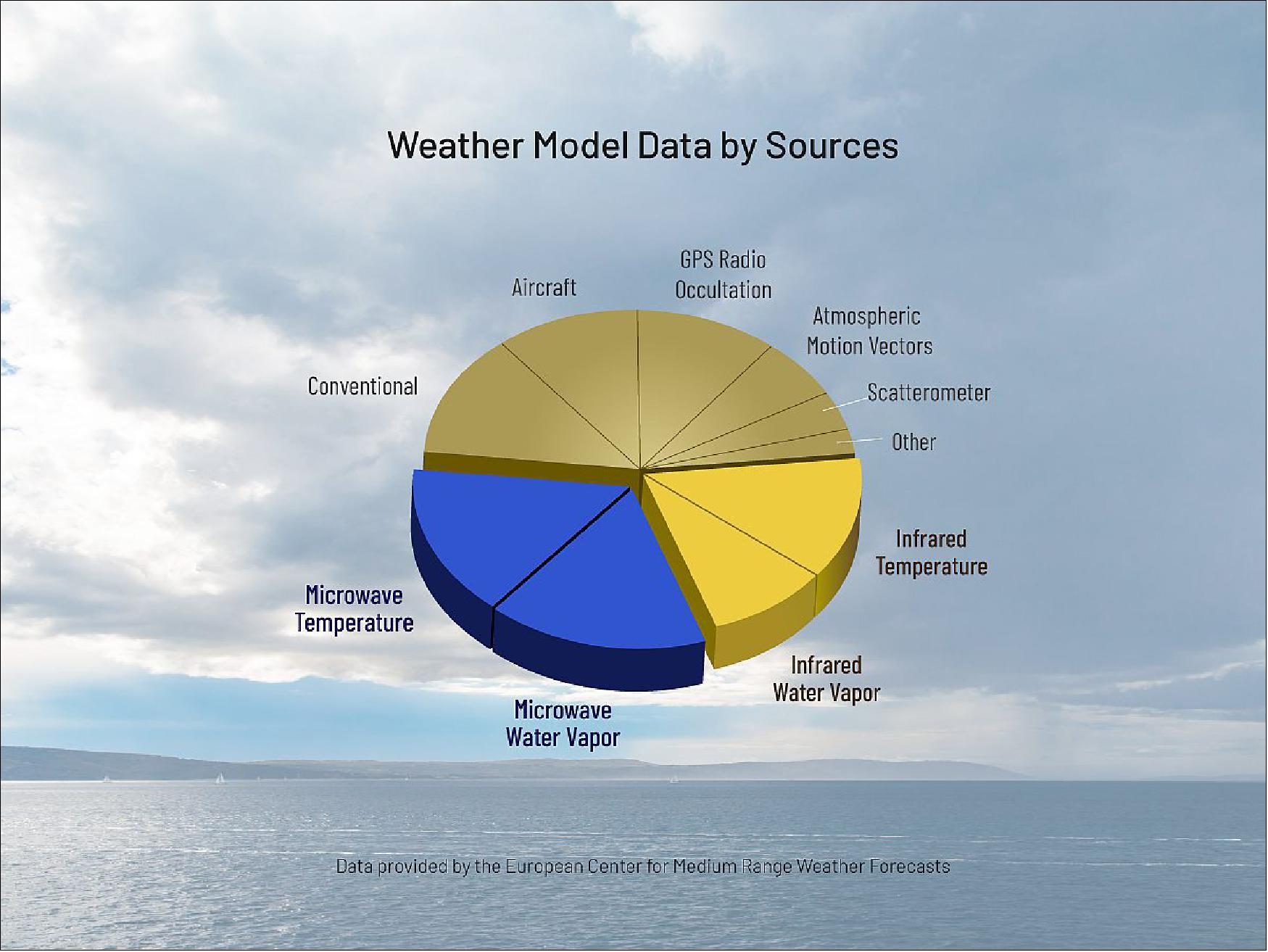
Also radiating energy are all the molecules in the atmosphere. - As molecules vibrate, they’re emitting energy that can be observed “in the same way that a hot piece of metal, like a burner on your stove, glows orange when it gets hot,” said Dr. Carl Mears, vice president for research at Remote Sensing Systems.
Each type of molecule vibrates at certain frequencies and emits radiation at those frequencies. The warmer the gases are, the more vibration occurs, and thus the amount of emitted radiation increases. And by measuring at these different frequencies, scientists can determine the temperature and moisture at different layers of the atmosphere.
Microwave Sounders Measure Climate Change
Microwave sounders do something else, something few anticipated when first designing the instruments: they give us long-term records of the temperature of our atmosphere — and they show us how it’s changing.
In the mid-1990s, Dr. Ben Santer, an atmospheric scientist who recently retired from the Lawrence Livermore National Laboratory after a 29-year tenure there, was convening lead author of Chapter 8 of the IPCC’s second assessment report. As such, he wrote what would become one of the most important sentences in climate science history: “The balance of evidence suggests a discernible human influence on global climate.”

The evidence then focused mostly on the warming of land and ocean surfaces, and the finding was met with fierce pushback. Scientists were challenged to show more evidence of a human-caused warming signal in ocean temperatures, rainfall, water vapor, and, importantly, satellite records of atmospheric temperature.
Santer’s personal response, he said, was “to interrogate these microwave measurements of atmospheric temperature records.” At that time, the record of microwave sounders was relatively short, spanning just 17 years. Still, Santer said, “it seemed critically important, despite the constraint of the very short record, to start looking at this data, and to see what it told us about global warming.
Fast forward to present day. The data record from microwave sounders now stretches 42 years, long enough to show clear trends in both the lower and upper atmosphere. And after years of rigorous work by scientists around the globe, the latest IPCC report, released in August 2021 said it is “unequivocal” that the climate is changing and humans are to blame. U.N. Secretary-General António Guterres called the report, released during a summer of massive wildfires, floods and drought, a “code red for humanity.”
“The alarm bells are deafening, and the evidence is irrefutable,” Guterres said in a statement: “Greenhouse‑gas emissions from fossil-fuel burning and deforestation are choking our planet and putting billions of people at immediate risk.”
But, he added, cleaner air, better health and prosperity are still possible “if we respond to this crisis with solidarity and courage."
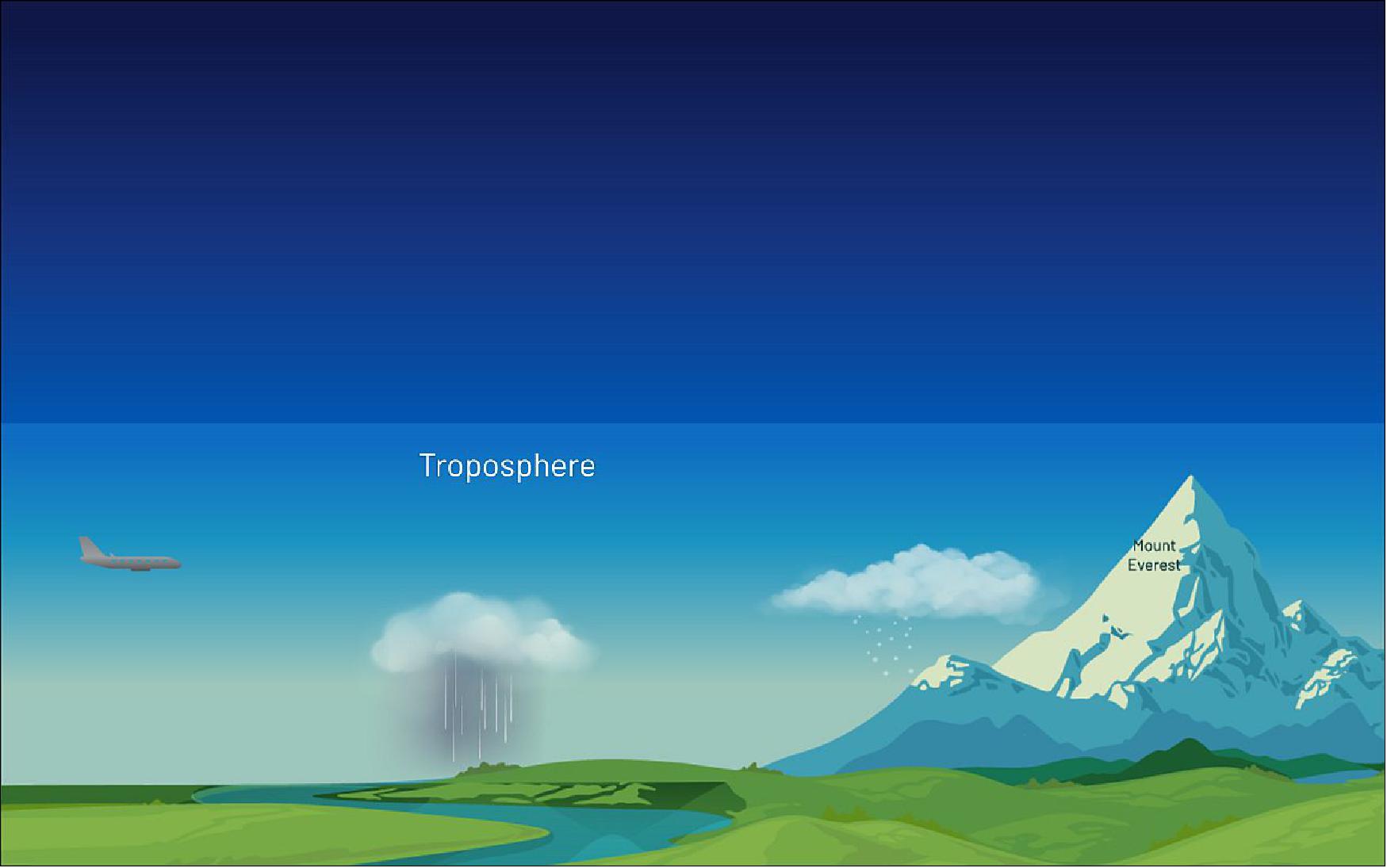
Above that, starting from an altitude of about 9 miles (~14 km)and stretching about 22 miles (35 km) more, is the stratosphere, where the ozone layer is, and where temperatures rise with height. The tropopause marks the boundary between the two.
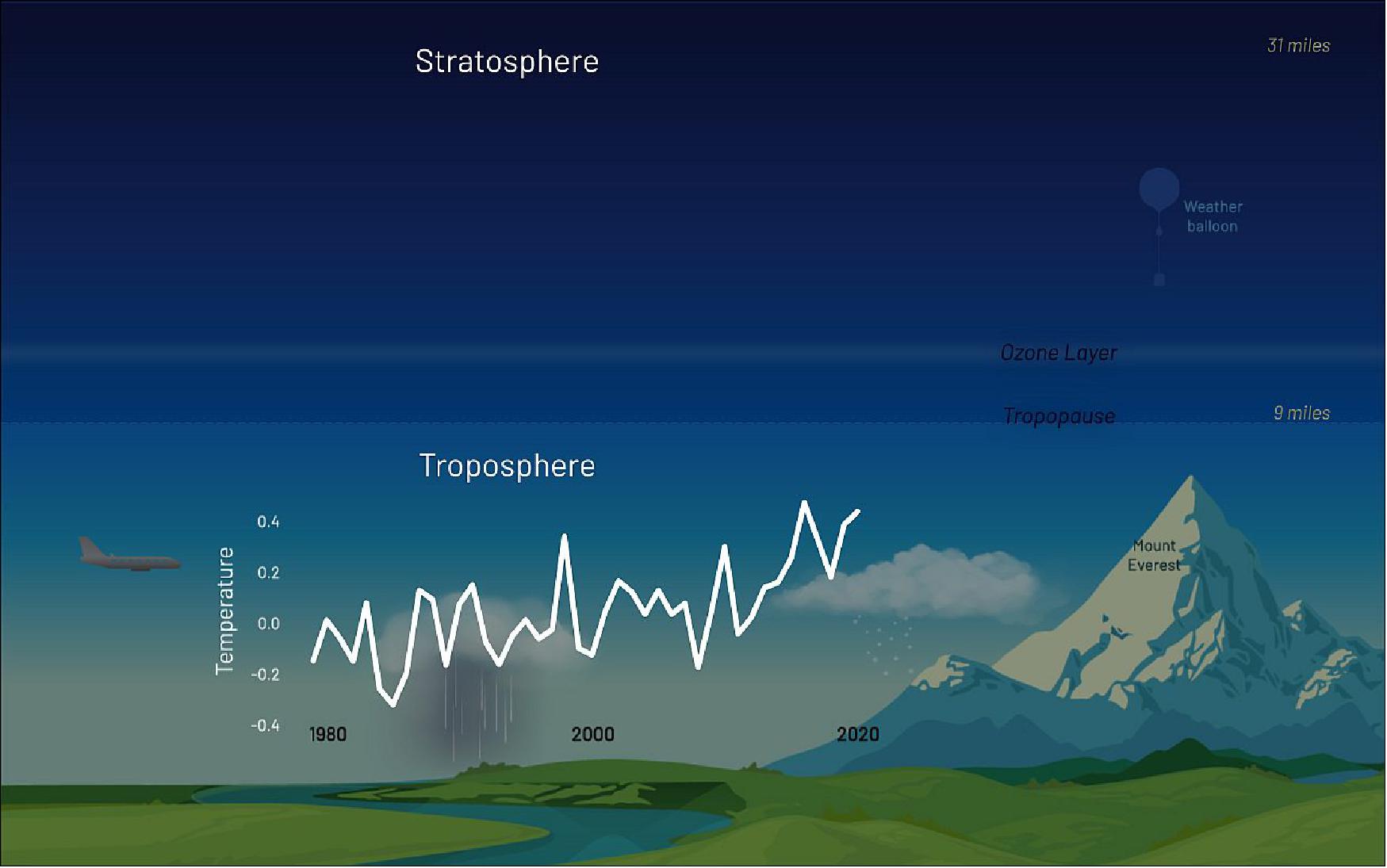
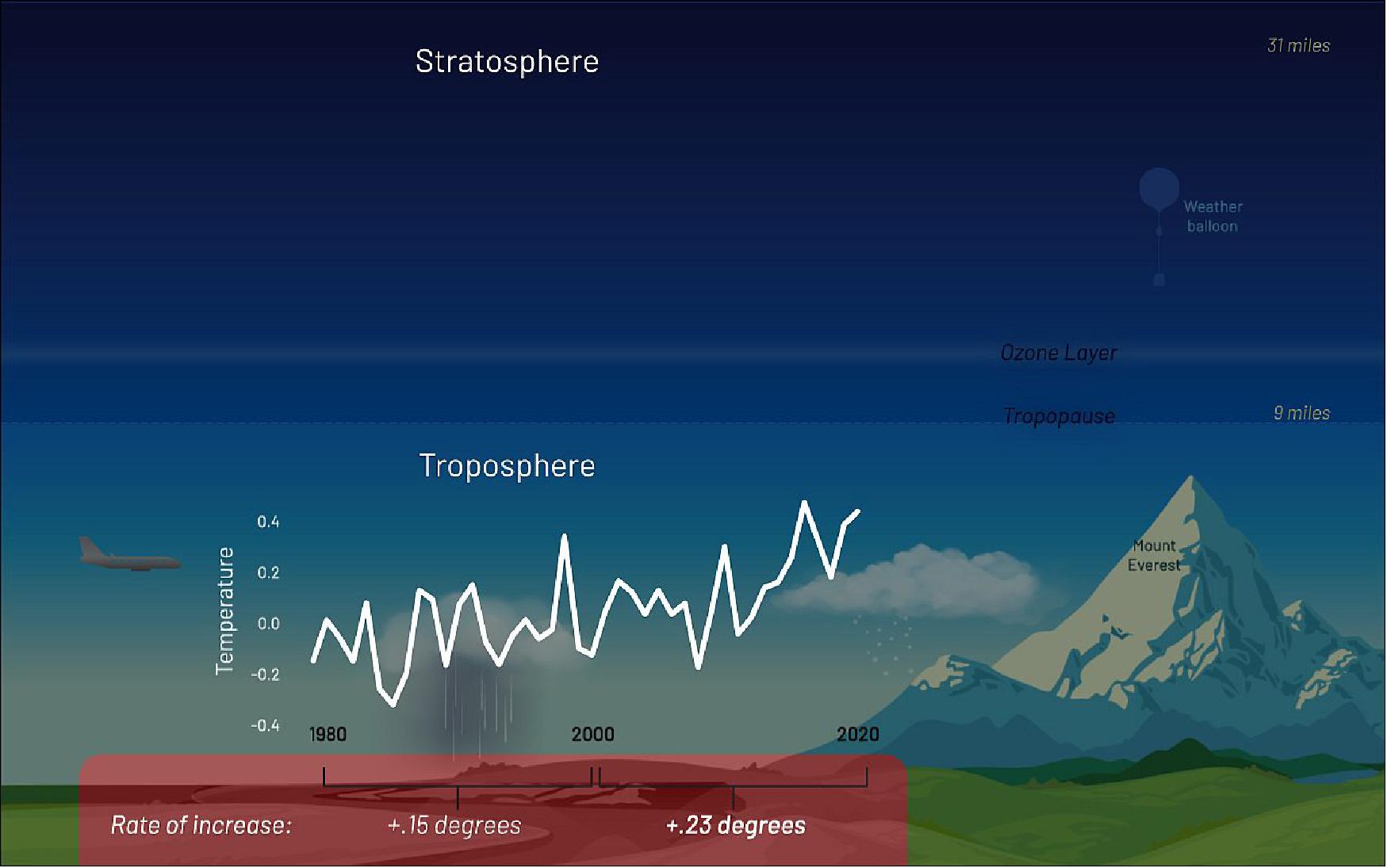
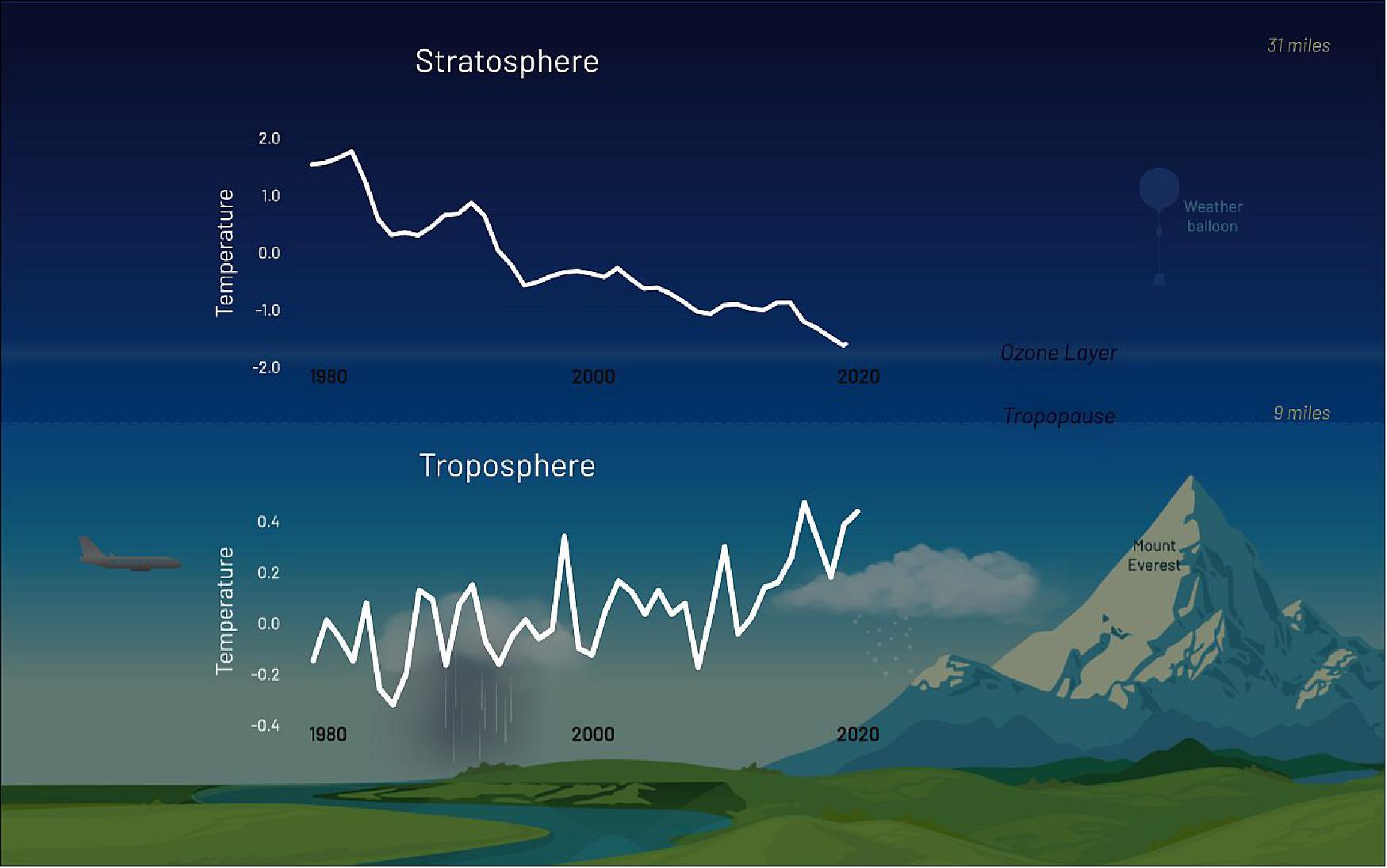
If Earth was warming for another reason, due to the Sun getting brighter, for example, both the stratosphere and the troposphere would warm. But, Mears said, “because the stratosphere is cooling, that’s a fingerprint of putting a blanket on the Earth and keeping more heat close to the surface. And it means there’s less heat available to heat the stratosphere.” In other words, energy is being trapped in the troposphere by greenhouse gases.
Computer models of the climate have helped scientists separate natural changes in the Earth's climate, such as volcanic eruptions and changes in solar activity, from human influences, such as deforestation, particulate pollution, and the release of greenhouse gases from the burning of fossil fuels. When the models are run without human influences, you don’t see much temperature change, Dr. Mears said: “Then we run them with human effects, and they agree fairly well with what we’ve observed.”
Those human influences can be seen in atmospheric temperature measurements, but also in the scores of different ways scientists evaluate global warming: measurements of surface temperature, water vapor and sea ice, for example. “All of these measurements point in the same direction,” Mears said.
Getting the Measurements Right
The satellite records of atmospheric temperature have historically been a target of controversy. Multiple groups have used the sounding data to create satellite temperature trends. For years, the data were misanalyzed by one of these groups. The resulting trend showed less warming than was really occurring, and even cooling in the tropics where the atmosphere was in fact warming. These flawed findings were then used, Dr. Santer said, "to cast doubt on the reality and seriousness of global warming."
Getting the satellite measurements right required overcoming a number of challenges: Most notably, the older satellites that carried microwave sounders weren’t as well calibrated and their orbits drifted over time.
But over the years, these errors have been systematically corrected by teams of scientists studying these datasets.
In fact, a paper published in the journal Science Advances in 2018 found that the errors that accounted for these differences in temperature trends have been nearly eliminated. Temperature measurements from ATMS have achieved what the paper’s lead author Dr. Cheng-Zhi Zou, a research scientist with the NOAA's Center for Satellite Applications and Research, refers to as “absolute stability within .04 Kelvin per decade." A follow-up paper published in Geophysical Research Letters in June 2021 further reduced the uncertainty. 3) 4)
“The uncertainty is so small, the calibration is so well done — it shows these post-millennium measurements are well suited for climate change monitoring, said Dr. Qiang Fu, an atmospheric scientist with University of Washington and a co-author with Dr. Zou on the Geophysical Research Letters study.
A Story of Progress
The story of the microwave sounder is the story of scientific progress. To be able to stitch together climate-worthy data records from an instrument never meant for this purpose took hard work and ingenuity. It meant repeatedly finding new ideas and scrubbing old ones—and having different groups competing didn’t hurt, Mears said.
There’s still work to be done when it comes to splicing together the records from the older sounders and incorporating data from ATMS. It’s not a thermometer in space, Santer pointed out. It’s a complicated instrument.
“But the bottom line,” he said, “is that we’ve learned that these measurements not intended or designed to monitor long-term multi-decadal changes in climate are extremely useful for getting a better sense of long-term changes in climate.”
“The microwave sounder, which was often viewed as evidence of the absence of human-influenced climate change, actually provides just the contrary," Santer said: "Very powerful evidence of the existence of human fingerprints on the climate system.”
The Future of Sounding
The downside of microwave sounders is that we don’t have enough of them, said Dr. Sid Boukabara, principal scientist with the NOAA Center for Satellite Applications and Research. And we don’t have enough observations of every inch of the atmosphere.
“We need to understand what’s happening now — and everywhere —to be able to accurately predict what’s going to happen in the future," he said. "If we need a full picture of the globe every hour, for example, as will likely be expected for future weather prediction models, we need more satellites.”
Meanwhile, the JPSS-2 satellite, which is slated to launch in 2022 with another ATMS instrument on board, will give us more eyes in the sky to monitor atmospheric rivers, severe storms and daily weather —and more data to feed the global temperature archive.
And it will give us the information we need to live our lives, whether that’s knowing tomorrow's weather or what our world might look like in 50 years.
References
1) ”The most important instrument you've never heard of,” NASA Feature, 7 October 2021, URL: https://www.nasa.gov/feature/the-most-important-instrument-you-ve-never-heard-of
2) Jenny Marder, Visuals by Jefferson Beck, Graphics by Vi Nguyen, JPSS satellite animations by Lamont W. Harvey, Data visualizations by Cynthia Starr, NASA Scientific Visualization Studio, Video by Jefferson Beck, Lauren Ward, Edited by Ashley Hume, Peter Jacobs, Jacob Richmond, ”This little-known tool affects our daily lives and helps us understand our weather and climate,” 7 October 2021, URL: https://storymaps.arcgis.com/stories/90de52ccc6e04ba1b50b68e0d1057bf7
3) Cheng-Zhi Zou, Mitchell D. Goldberg, and Xianjun Hao, ”New generation of U.S. satellite microwave sounder achieves high radiometric stability performance for reliable climate change detection,” Science Advances, Published online 17 October 2018, eaau0049, https://www.science.org/doi/10.1126/sciadv.aau0049
4) Cheng-Zhi Zou, Hui Xu, Xianjun Hao, Qiang Fu, ”Post-Millennium Atmospheric Temperature Trends Observed From Satellites in Stable Orbits,” Geophysical Research Letters, Volume48, Issue13, 16 July 2021, e2021GL093291, https://doi.org/10.1029/2021GL093291